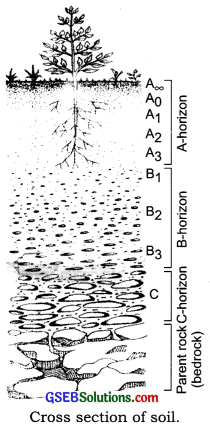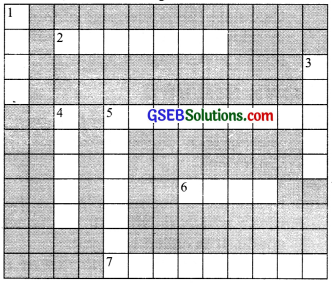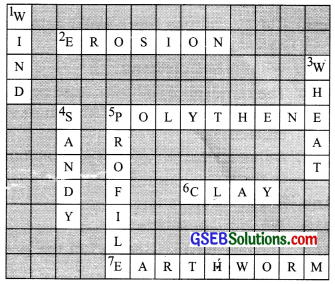Gujarat Board GSEB Textbook Solutions Class 7 Science Chapter 9 Soil Textbook Questions and Answers, Additional Important Questions, Notes Pdf.
Gujarat Board Textbook Solutions Class 7 Science Chapter 9 Soil
Gujarat Board Class 7 Science Soil Textbook Questions and Answers
![]()
Tick the most suitable answer in questions 1 and 2
Question 1.
In addition to the rock particles, the soil contains
(i) air and water
(ii) water and plants
(iii) minerals, organic matter, air and water
(iv) water, air and plants
Answer:
(iii) minerals, organic matter, air and water.
Question 2.
The water holding capacity is the highest in:
(i) sandy soil
(ii) clayey soil
(iii) loamy soil
(iv) mixture of sand and loam
Answer:
(ii) clayey soil.
![]()
Question 3.
Match the items in Column I with those in Column II:
| Column I | Column II |
| (i) A home for living organisms | (a) Large, particles |
| (ii) Upper layer of the soil | (b) All kinds of soil |
| (iii) Sandy soil | (c) Dark in colour |
| (iv) Middle layer of the soil | (d) Small particles and packed tight |
| (v) Clayey soil | (e) Lesser amount of humus |
Answer:
| Column I | Column II |
| (i) A home for living organisms | (b) All kinds of soil |
| (ii) Upper layer of the soil | (c) Dark in colour |
| (iii) Sandy soil | (a) Large, particles |
| (iv) Middle layer of the soil | (e) Lesser amount of humus |
| (v) Clayey soil | (d) Small particles and packed tight |
Question 4.
Explain how soil is formed.
Answer:
- The big and heavy rocks are broken into smaller pieces and come on the surface of the earth.
- Soil is formed by breaking down of rocks by the action of wind, water and climate. This process is called weathering.
- The smaller particles of the rocks obtained due to weathering get further decomposed on long exposure to air and moisture.
- Finally the decomposed parts of dead plants and animals get mixed up with soil formed by above processes. This gives the soil enough energy in the form of organic matter.
Question 5.
How is clayey soil useful for crops?
Answer:
Clayey soil has good water retaining capacity. It is rich in humus and is very fertile. This is the reason why this soil is useful for growing crops like wheat and rice.
Question 6.
List the differences between clayey soil and sandy soil.
Answer:
Clayey soil
- Proportion of fine particles is more than big particles.
- It has less percolation rate of water.
- It has good water holding capacity.
Sandy soil:
- Proportion of big particles is more than fine particles.
- It has more percolation rate of water.
- It has poor water holding capacity.
![]()
Question 7.
Sketch the cross section of soil and label the various layers.
Answer:

Question 8.
Razia conducted an experiment in the field related to the rate of percolation. She observed that it took 40 min for 200 mL of water to percolate through the soil sample. Calculate the rate of percolation.
Answer:
Given that
Amount of water = 200 mL
Time taken = 40 minutes
Rate of percolation (mL/min) amount of water

= 200 mL/40 min = 5 mL/min
Question 9.
Explain how soil pollution and soil erosion could be prevented.
Answer:
Prevention of soil pollution:
- There should be a ban on polythene bags and plastics.
- Waste products and chemicals should be treated before they are released into the soil.
- The use of pesticides should be minimised.
Prevention of soil erosion:
- By growing trees.
- By avoiding deforestation.
- By maintaining porous structure of soil.
- Control and reclamation of ravines and shifting of cultivation.
Question 10.
Solve the following crossword puzzle

Across:
2. Plantation prevents it.
5. Use should be banned to avoid soil pollution.
6. Type of soil used for making pottery.
7. Living organism in the soil.
Down:
1. In desert soil erosion occurs through.
3. Clay and loam are suitable for cereals like.
4. This type of soil can hold very little water.
5. Collective name for layers of soil.
Answer:

Extended Learning – Activities And Projects
Question 1.
Boojho would like to know the difference between raw and baked soil? Investigate how the soil from which matkas are made is different from the soil used to make statues.
Answer:
Raw soil – It is white or dull (blackish) coloured soil. It contains water molecules in it. It also has air in it.
Baked soil – When raw soil is heated then it is called baked soil. This type of soil has lost its water molecules due to heating. Its colour becomes reddish. The soil used in making matkas is mixed with horse-dung and prepared. Matkas are baked while statues are formed by best quality of raw clay soil.
![]()
Question 2.
Paheli is worried. She could see a brick kiln from her house. Bricks were being made there. There was so much smoke coming out of the kiln. She was told that the best quality of clay is required for making pottery, statues and bricks. She has seen truck loads of bricks being taken away for construction of buildings. At this rate, she fears, no soil will be left. Are her fears justified? Discuss this problem with your parents, teachers and other experts of your area and prepare a report.
Answer:
The soil has a capacity to replenish itself gradually, so her fear is not correct. But when the soil is used at a very higher rate than the rate of replenish of the soil, then her fear is correct. Discuss this with your teachers, parents and friends.
Question 3.
Try to find out the moisture content of a soil sample. One method is given here. Activity: Take 100 g soil. (Take help from any shopkeepers to weigh the soil.) Place it on a newspaper in the sun and allow it to dry for two hours. This activity is best done in the afternoon. Take care that the soil does not spill outside the newspaper. After drying it, weigh the soil again. The difference in the weight of the soil before and after drying gives you the amount of moisture contained in 100 g of soil. This is called the percentage moisture content. Suppose your sample of soil loses 10 g on drying. Then Per cent of moisture in soil
![]()
In this example:
Per cent of moisture in soil = \(\frac { 10 × 100 }{ 100 }\) = 10%
Answer:
Do it yourself according to the activity. Calculate the percentage of moisture by taking samples of soil from different places and compare them.